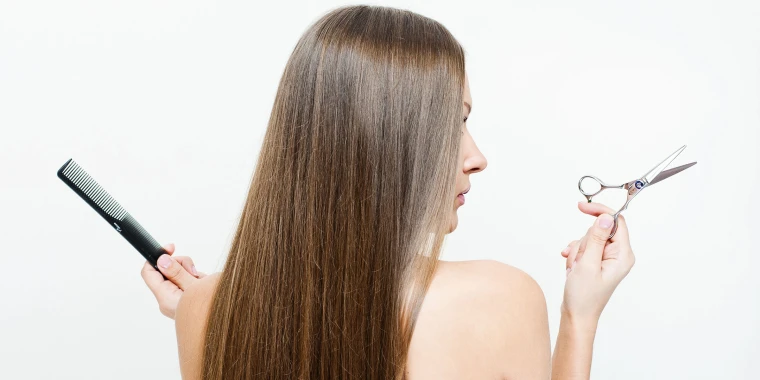Contents
12 Inches? (And Why)
Exact answer: A little less than two years.
There are numerous methods to grow hair longer, but one of the most well-known is by managing. Managing the hair will allow it to grow stronger and keep split ends under control. This cycle does not necessitate a trip to the salon, as one can easily trim their hair for certain basic devices at home.
With the number of hair follicles one can have in a lifetime, the follicles will eventually stop producing hair. Overall, hair grows one and a half inches per month, so it takes less than two years to reach the 12-inch mark.

How long does it take to grow hair 12 inches?
Duration of Hair Growth
The rate of hair development is determined by the individual and changes as a result of various factors such as age, heredity, chemicals, and diet.
When in doubt, it will take at least two years before anyone sees any significant length expansion in their hair development, but there are several ways it can help with increasing the rate at which the hair develops.
Protein-rich foods such as eggs and fish will frequently increase the size of follicles, while vitamin A can help fortify and protect them from breakage. Egyptian ladies have traditionally used henna powder for both corrective and restorative purposes (advances sound development).
These medications should be supplemented with nutrients such as biotin (for solid greasy tissues).
It takes about two years to grow hair that is 12 inches long.
How Long Can I Have Another Baby After a Cesarean (And Why)?
The average growth rate of solid hair is around 6cm (2.4 inches) per half year. Obviously, this varies depending on hereditary characteristics or fundamental medical issues, but for the vast majority, this is the estimated time it will take to develop their hair twelve creeps long.
The gauge does not represent any external elements – if one is undergoing treatments such as chemotherapy, the rate will be much lower.
To look great with tallness challenging locks sooner, all one has to do is stimulate new hair development with nutrients and minerals. Because younger people develop hair faster than older people, try to avoid foods high in protein and calcium.
Why Would It Take So Long to Grow Hair 12 Inches?
It is determined by how long it takes a follicle to produce 3 cm of hair.
The medulla, cortex, and fingernail skin are the three main components of hair. Significant amounts of follicular action increase levels of production. A study of mice found that by removing them from occasional light-dim cycles, they sped up hair development while resetting their typical circadian rhythms.
More limited strands require less energy to maintain than longer ones, so if the goal is simply length, one is in an ideal situation letting it be. Hair can also recover after being trimmed or artificially adjusted with no noticeable signs.
A hair grows an average of 6 inches per year, though some people’s hair can grow up to 8 inches per year. It usually takes at least two years for long hair to grow to a length of 12 inches or one inch per month without the use of styling or other methods.
How Long Can I Take Sudafed After Taking Zyrtec (And Why)?
The time it takes for the scalp to regrow new hairs and replace old ones varies from person to person.
On the other hand, the less one cuts or synthetically processes their locks, the more room one has to develop at their normal rate – which could take up to a half year longer than another person’s normal development rate.
Nutrients A, D, E, and C aid in the stimulation of viable hair development. Restriction with hair interpretations such as hot irons or the hairdryer will significantly worsen the condition. A poor eating regimen may be one of the reasons why hair development is slowing.
How can people make their hair grow faster?
How long does it take to grow hair 12 inches? When thinking about ways to support your hair, it’s easy to believe that hair development has nothing to do with, say, how solid your dissemination is or how well that burrito from lunch is being processed. However, your body’s cells all rely on one another to keep you in balance. As a result, developing hair can quickly fall from the top of your body’s schedule when a bigger issue emerges. At that point, the typical assets held for hair development will be assigned to more significant activities.

Various dysfunctions have been linked to potential hair loss, including poor nutrition, hormonal imbalances, increased pressure, oxidative pressure from things like contaminations, and general irritation. Your inherited traits play a role as well.
Anyway, what is the solution to promoting your best hair development? Generally assisting your body! A multi-targeted approach, such as Nutrafol, helps support the needs of your hair follicles while also eradicating any expected stumbling blocks to development. Curcumin, for example, has been shown in studies to work extremely hard in supporting a solid incendiary reaction. Nutrients such as A, D, E, and C, as well as supplements such as zinc and selenium, help to keep your invulnerable motion within proper limits. Furthermore, adaptogenic spices such as ashwagandha can help your body develop a higher resistance to stretching. These fixings are conveniently included in each Nutrafol container.
Is age a factor?
While changes to hair follicles and their environment are common as we age, this does not mean that your long hair dreams are out of reach. You can achieve your long hair goals with the right supplement regimen and a healthy lifestyle.
For example, as we get older, our chances of running into hormone-related hair-growth roadblocks increase. If the hormone DHT is wreaking havoc on your hair, consider taking saw palmetto, which has DHT-inhibiting properties. Starting in our twenties, our skin’s production of collagen, the protein complex that keeps our hair follicles snugly nestled into our skin, naturally decreases. Supporting this production with nutrients such as vitamin C and amino acids such as cysteine can also help hair thrive at any age.
Small pockets of inflammation at our hair follicles can become more common as we age, making it a good idea to consider the support of inflammation-balancing nutrients like fish oil.
Should I cut my hair to encourage it to grow?

How long does it take to grow hair 12 inches? It take a little less than 2 years. While regular trims are important for keeping your hair looking healthy, let’s dispel the myth that “trimming your hair makes it grow faster.” Though it would be undeniably convenient if snipping off a few centimetres signalled our hair follicles to increase their activity, experts have definitively rejected this assumption. Our hair follicles receive instructions on when and how to resume hair growth from much deeper signals, according to research. These include genetics, nutrition, and the messages our hormones send.
Do hair care products make a difference?
Long hair necessitates a little more care to keep it looking its best. And the products you choose are just as important as the ones you don’t. Researchers have linked the following hair product ingredients to hormone disruption or cell damage: formaldehyde, parabens, phthalates, octinoxate, and various chemicals hidden under the label “fragrance” or “perfume.”
Sticking to organic, sulfate-free options is a good place to start when selecting your products. Sulfates, such as sodium lauryl sulphate (a common shampoo cleansing agent), have been shown to increase protein loss in hair, paving the way for damage. The EWG’s skin deep Database has easy-to-reference guidelines for questionable ingredients.
If split ends in particular are a concern, here’s good news: Research has shown that conditioning treatments help strengthen hair and make it more resilient to damage. Coconut oil hair masks, for example, have become a popular at-home hair treatment, likely stemming from research supporting coconut oil’s exceptional ability to penetrate hair strands and help hair resist damage from styling.
Conclusion
When it comes to using different hair care products, it might help hair growth, but sometimes it may cause more damage than good.
Keep doing a deep condition treatment every week or two and trimming the ends every six weeks to get started. This will keep the locks hydrated while they’re growing out.
Trimming one’s hair also prevents one from getting a suitable haircut. If you don’t know what you’re doing, you might end up with an uneven cut. The good news is that you no longer have to be concerned about any of these issues.
